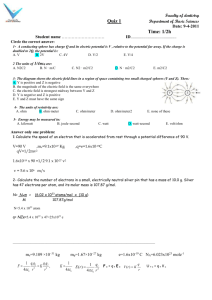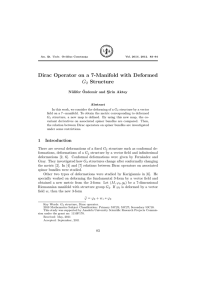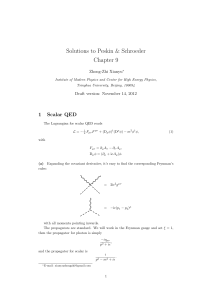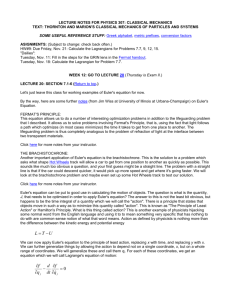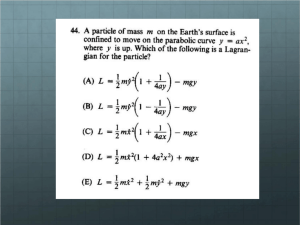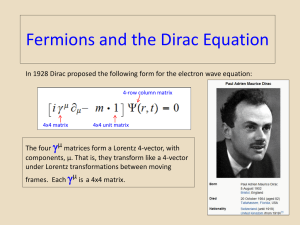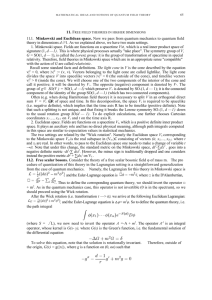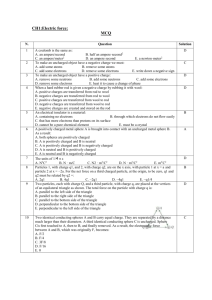Solutions to Peskin & Schroeder Chapter 3
advertisement
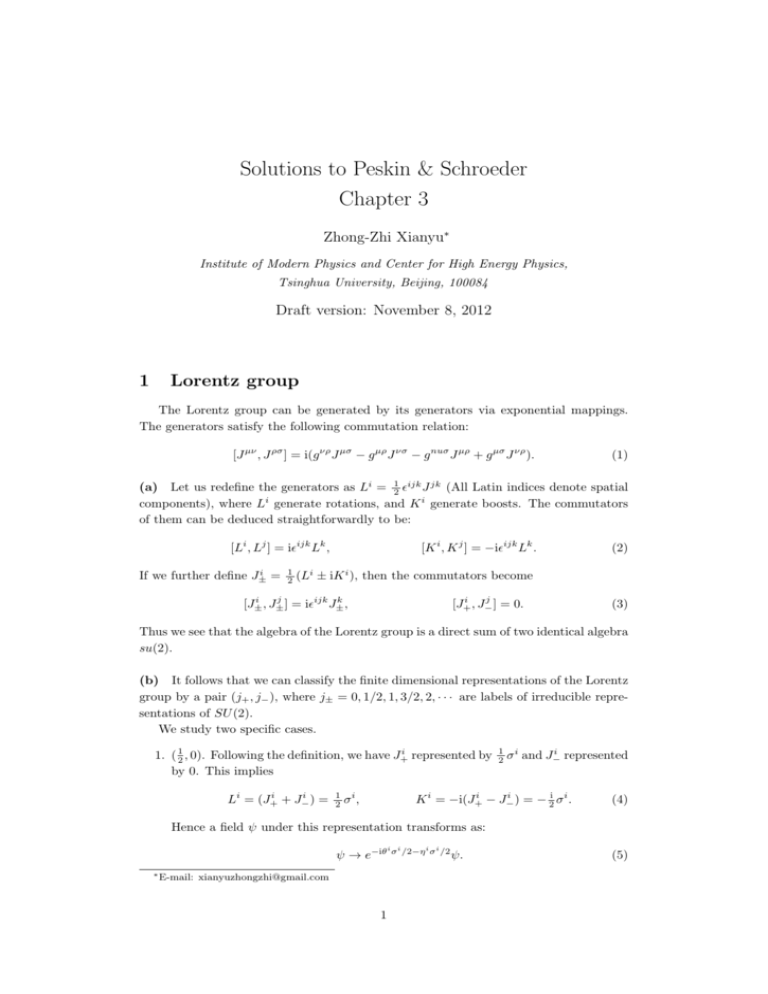
Solutions to Peskin & Schroeder
Chapter 3
Zhong-Zhi Xianyu∗
Institute of Modern Physics and Center for High Energy Physics,
Tsinghua University, Beijing, 100084
Draft version: November 8, 2012
1
Lorentz group
The Lorentz group can be generated by its generators via exponential mappings.
The generators satisfy the following commutation relation:
[J µν , J ρσ ] = i(g νρ J µσ − g µρ J νσ − g nuσ J µρ + g µσ J νρ ).
(1)
(a) Let us redefine the generators as Li = 12 ϵijk J jk (All Latin indices denote spatial
components), where Li generate rotations, and K i generate boosts. The commutators
of them can be deduced straightforwardly to be:
[K i , K j ] = −iϵijk Lk .
[Li , Lj ] = iϵijk Lk ,
i
If we further define J±
=
1
2
(2)
(Li ± iK i ), then the commutators become
j
i
[J+
, J−
] = 0.
j
k
i
] = iϵijk J±
,
[J±
, J±
(3)
Thus we see that the algebra of the Lorentz group is a direct sum of two identical algebra
su(2).
(b) It follows that we can classify the finite dimensional representations of the Lorentz
group by a pair (j+ , j− ), where j± = 0, 1/2, 1, 3/2, 2, · · · are labels of irreducible representations of SU (2).
We study two specific cases.
i
1. ( 12 , 0). Following the definition, we have J+
represented by
by 0. This implies
i
i
Li = (J+
+ J−
)=
1
2
1
2
i
σ i and J−
represented
i
i
K i = −i(J+
− J−
) = − 2i σ i .
σi ,
(4)
Hence a field ψ under this representation transforms as:
ψ → e−iθ
∗ E-mail:
xianyuzhongzhi@gmail.com
1
i
σ i /2−η i σ i /2
ψ.
(5)
Notes by Zhong-Zhi Xianyu
Solution to P&S, Chapter 3 (draft version)
i
i
2. ( 12 , 0). In this case, J+
→ 0, J−
→
i
i
Li = (J+
+ J−
)=
1
2
1
2
σ i . Then
i
i
K i = −i(J+
− J−
)=
σi ,
i i
2σ .
(6)
Hence a field ψ under this representation transforms as:
ψ → e−iθ
i
σ i /2+η i σ i /2
ψ.
(7)
We see that a field under the representation ( 12 , 0) and (0, 12 ) are precisely the left-handed
spinor ψL and right-handed spinor ψR , respectively.
(c) Let us consider the case of ( 21 , 12 ). To put the field associated with this representation into a familiar form, we note that a left-handed spinor can also be rewritten as
row, which transforms under the Lorentz transformation as:
(
)
T 2
T 2
ψL
σ → ψL
σ 1 + 2i θi σ i + 12 η i σ i .
(8)
Then the field under the representation ( 12 , 12 ) can be written as a tensor with spinor
indices:
)
(
V 0 + V 3 V 1 − iV 2
T 2
µ
ψR ψL σ ≡ V σ̄µ =
.
(9)
V 1 + iV 2 V 0 − V 3
In what follows we will prove that V µ is in fact a Lorentz vector.
A quantity V µ is called a Lorentz vector, if it satisfies the following transformation
law:
V µ → Λµν V ν ,
(10)
where Λµν = δνµ − 2i ωρσ (J ρσ )µ ν in its infinitesimal form. We further note that:
(J ρσ )µν = i(δµρ δνσ − δνρ δµσ ).
(11)
and also, ωij = ϵijk θk , ω0i = −ωi0 = η i , then the combination V µ σ̄µ = V i σ i + V 0
transforms according to
(
)
(
)
i
i
i
V i σ i → δji − ωmn (J mn )i j V j σ i + − ω0n (J 0n )i 0 − ωn0 (J n0 )0 i V 0 σ i
2
2)
2
(
(
)
i
k
m n
m n
j i
i
i
= δj − 2 ϵmnk θ (−i)(δi δj − δj δi ) V σ + − iη (−i)(−δin ) V 0 σ i
=V i σ i − ϵijk V i θj σ k + V 0 η i σ i ,
)
i
i
ω0n (J 0n )0i − ωn0 (J n0 )0i V i
2
2
(
) i
0
i
n
0
= V + − iη (iδi ) V = V + η i V i .
V0 → V0+
(
−
In total, we have
(
)
V µ σ̄µ → σ i − ϵijk θj σ k + η i V i + (1 + η i σ i )V 0 .
(12)
If we can reach the same conclusion by treating the combination V µ σ̄µ a matrix transforming under the representation ( 12 , 12 ), then our original statement will be proved. In
fact:
)
(
)
(
i
i
1
1
V µ σ̄µ → 1 − θj σ j + η j σ j V µ σµ 1 + θj σ j + η j σ j
2
2
2
2
(
i j i j
1 j i j ) i
i
= σ + θ [σ , σ ] + η {σ , σ } V + (1 + η i σ i )V 0
2
2
( i
) i
ijk j k
i
= σ − ϵ θ σ + η V + (1 + η i σ i )V 0 ,
(13)
as expected. Hence we proved that V µ is a Lorentz vector.
2
Notes by Zhong-Zhi Xianyu
2
Solution to P&S, Chapter 3 (draft version)
The Gordon identity
In this problem we derive the Gordon identity,
ū(p′ )γ µ u(p) = ū(p′ )
( p′µ + pµ
2m
+
iσ µν (p′ν − pν ) )
u(p).
2m
(14)
Let us start from the right hand side:
)
(
1
ū(p′ ) (p′µ + pµ ) + iσ µν (p′ν − pν ) u(p)
2m
)
(
1
1
=
ū(p′ ) η µν (p′ν + pν ) − [γ µ , γ ν ](p′ν − pν ) u(p)
2m
2
(1
)
1
1
=
ū(p′ )
{γ µ , γ ν }(p′ν + pν ) − [γ µ , γ ν ](p′ν − pν ) u(p)
2m
2
2
(
)
1
′ µ
µ
′ µ
=
ū(p′ ) p
/γ +γ p
/ u(p) = ū(p )γ u(p) = LHS,
2m
RHS. =
where we have used the commutator and anti-commutators of gamma matrices, as well
as the Dirac equation.
3
The spinor products
In this problem, together with the Problems 5.3 and 5.6, we will develop a formalism
that can be used to calculating scattering amplitudes involving massless fermions or
vector particles. This method can profoundly simplify the calculations, especially in the
calculations of QCD. Here we will derive the basic fact that the spinor products can be
treated as the square root of the inner product of lightlike Lorentz vectors. Then, in
Problem 5.3 and 5.6, this relation will be put in use in calculating the amplitudes with
external spinors and external photons, respectively.
To begin with, let k0µ and k1µ be fixed four-vectors satisfying k02 = 0, k12 = −1 and
k0 · k1 = 0. With these two reference momenta, we define the following spinors:
1. Let uL0 be left-handed spinor with momentum k0 ;
2. Let uR0 = k/1 uL0 ;
3. For any lightlike momentum p (p2 = 0), define:
uL (p) = √
1
p
/uR0 ,
2p · k0
uR (p) = √
1
p
/uL0 .
2p · k
(15)
(a) We show that k/0 uR0 = 0 and p
/uL (p) = p
/uR (p) = 0 for any lightlike p. That is,
uR0 is a massless spinor with momentum k0 , and uL (p), uR (p) are massless spinors with
momentum p. This is quite straightforward,
k/0 uR0 = k/0 k/1 uL0 = (2g µν − γ ν γ µ )k0µ k1ν uL0 = 2k0 · k1 uL0 − k/1 k/0 uL0 = 0,
(16)
and, by definition,
p
/uL (p) = √
1
1
p2 uR0 = 0.
p
/p
/uR0 = √
2p · k0
2p · k0
In the same way, we can show that p
/uR (p) = 0.
3
(17)
Notes by Zhong-Zhi Xianyu
Solution to P&S, Chapter 3 (draft version)
(b) Now we choose k0µ = (E, 0, 0, −E) and k1µ = (0, 1, 0, 0). Then in the Weyl
representation, we have:
0 0 0 0
0 0 0 2E
k/0 uL0 = 0 ⇒
(18)
uL0 = 0.
2E 0 0 0
0 0 0 0
√
Thus uL0 can be chosen to be (0, 2E, 0, 0)T , and:
0
0
0 0 1
0
0
0 1 0
(19)
uR0 = k/1 uL0 =
uL0 = √ .
− 2E
0 −1 0 0
−1 0 0 0
0
Let pµ = (p0 , p1 , p2 , p3 ), then:
uL (p) = √
1
p
/uR0
2p · k0
0
1
0
= √
2E(p0 + p3 ) p0 − p3
−p1 − ip2
−(p0 + p3 )
−(p + ip )
1
1
2
=√
.
p0 + p3
0
0
In the same way, we get:
(c)
0
0
−p1 + ip2
p0 + p3
p0 + p3
p1 + ip2
0
0
p1 − ip2
p0 − p3
uR0
0
0
(20)
0
1
0
uR (p) = √
.
p0 + p3 −p1 + ip2
p0 + p3
(21)
We construct explicitly the spinor product s(p, q) and t(p, q).
s(p, q) = ūR (p)uL (q) =
(p1 + ip2 )(q0 + q3 ) − (q1 + iq2 )(p0 + p3 )
√
;
(p0 + p3 )(q0 + q3 )
(22)
t(p, q) = ūL (p)uR (q) =
(q1 − iq2 )(p0 + p3 ) − (p1 − ip2 )(q0 + q3 )
√
.
(p0 + p3 )(q0 + q3 )
(23)
It can be easily seen that s(p, q) = −s(q, p) and t(p, q) = (s(q, p))∗ .
Now we calculate the quantity |s(p, q)|2 :
(
)2 (
)2
p1 (q0 + q3 ) − q1 (p0 + p3 ) + p2 (q0 + q3 ) − q2 (p0 + p3 )
2
|s(p, q)| =
(p0 + p3 )(q0 + q3 )
q
+
q
p0 + p3
0
3
=(p21 + p22 )
+ (q12 + q22 )
− 2(p1 q1 + p2 q2 )
p0 + p3
q0 + q3
=2(p0 q0 − p1 q1 − p2 q2 − p3 q3 ) = 2p · q.
(24)
Where we have used the lightlike properties p2 = q 2 = 0. Thus we see that the spinor
product can be regarded as the square root of the 4-vector dot product for lightlike
vectors.
4
Notes by Zhong-Zhi Xianyu
4
Solution to P&S, Chapter 3 (draft version)
Majorana fermions
(a) We at first study a two-component massive spinor χ lying in ( 12 , 0) representation,
transforming according to χ → UL (Λ)χ. It satisfies the following equation of motion:
iσ̄ µ ∂µ χ − imσ 2 χ∗ = 0.
(25)
To show this equation is indeed an admissible equation, we need to justify: 1) It is
relativistically covariant; 2) It is consistent with the mass-shell condition (namely the
Klein-Gordon equation).
To show the condition 1) is satisfied, we note that γ µ is invariant under the simultaneous transformations of its Lorentz indices and spinor indices. That is Λµ ν U (Λ)γ ν U (Λ−1 ) =
γ µ . This implies
Λµ ν UR (Λ)σ̄ ν UL (Λ−1 ) = σ̄ µ ,
as can be easily seen in chiral basis. Then, the combination σ̄ µ ∂µ transforms as σ̄ µ ∂µ →
UR (Λ)σ̄ µ ∂µ UL (Λ−1 ). As a result, the first term of the equation of motion transforms as
[
]
iσ̄ µ ∂µ χ → iUR (Λ)σ̄ µ ∂µ UL (Λ−1 )UL (Λ)χ = UR (Λ) iσ̄ µ ∂µ χ .
(26)
To show the full equation of motion is covariant, we also need to show that the second
term iσ 2 χ∗ transforms in the same way. To see this, we note that in the infinitesimal
form,
UL = 1 − iθi σ i /2 − η i σ i /2,
UR = 1 − iθi σ i /2 + η i σ i /2.
Then, under an infinitesimal Lorentz transformation, χ transforms as:
χ → (1 − iθi σ i /2 − η i σ i /2)χ,
⇒
⇒
χ∗ → (1 + iθi σ i /2 − η i σ i /2)χ∗
σ 2 χ∗ → σ 2 (1 + iθi (σ ∗ )i /2 − η i (σ ∗ )i /2)χ∗ = (1 − iθi σ i /2 + η i σ i /2)σ 2 χ∗ .
That is to say, σ 2 χ∗ is a right-handed spinor that transforms as σ 2 χ∗ → UR (Λ)σ 2 χ∗ .
Thus we see the the two terms in the equation of motion transform in the same way
under the Lorentz transformation. In other words, this equation is Lorentz covariant.
To show the condition 2) also holds, we take the complex conjugation of the equation:
−i(σ̄ ∗ )µ ∂µ χ∗ − imσ 2 χ = 0.
Combining this and the original equation to eliminate χ∗ , we get
(∂ 2 + m2 )χ = 0,
(27)
which has the same form with the Klein-Gordon equation.
(b) Now we show that the equation of motion above for the spinor χ can be derived
from the following action through the variation principle:
]
[
∫
im T 2
† 2 ∗
4
†
(χ σ χ − χ σ χ ) .
(28)
S = d x χ iσ̄ · ∂χ +
2
Firstly, let us check that this action is real, namely S ∗ = S. In fact,
[
]
∫
im † 2 ∗
S ∗ = d4 x χT iσ̄ ∗ · ∂χ∗ −
(χ σ χ − χT σ 2 χ)
2
5
Notes by Zhong-Zhi Xianyu
Solution to P&S, Chapter 3 (draft version)
The first term can be rearranged as
χT iσ̄ ∗ · ∂χ∗ = −(χT iσ̄ ∗ · ∂χ∗ )T = −(∂χ† ) · iσ̄χ = χ† iσ̄ · ∂χ + total derivative.
Thus we see that S ∗ = S.
Now we vary the action with respect to χ† , that gives
0=
δS
im
= iσ̄ · ∂χ −
· 2σ 2 χ∗ = 0,
δχ†
2
(29)
which is exactly the Majorana equation.
(c)
Let us rewrite the Dirac Lagrangian in terms of two-component spinors:
L = ψ̄(i∂/ − m)ψ
(
)(
)(
)
(
) 0 1
µ
−m
iσ
∂
χ
µ
1
†
= χ1 −iχT2 σ 2
iσ̄ µ ∂µ −m
iσ 2 χ∗2
1 0
(
)
= iχ†1 σ̄ µ ∂µ χ1 + iχT2 σ̄ µ∗ ∂µ χ∗2 − im χT2 σ 2 χ1 − χ†1 σ 2 χ∗2
)
(
= iχ†1 σ̄ µ ∂µ χ1 + iχ†2 σ̄ µ ∂µ χ2 − im χT2 σ 2 χ1 − χ†1 σ 2 χ∗2 ,
(30)
where the equality should be understood to hold up to a total derivative term.
(d) The familiar global U (1) symmetry of the Dirac Lagrangian ψ → eiα ψ now becomes χ1 → eiα χ1 , χ2 → e−iα χ2 . The associated Nöther current is
J µ = ψ̄γ µ ψ = χ†1 σ̄ µ χ1 − χ†2 σ̄ µ χ2 .
(31)
To show its divergence ∂µ J µ vanishes, we make use of the equations of motion:
iσ̄ µ ∂µ χ1 − imσ 2 χ∗2 = 0,
iσ̄ µ ∂µ χ2 − imσ 2 χ∗1 = 0,
i(∂µ χ†1 )σ̄ µ − imχT2 σ 2 = 0,
i(∂µ χ†2 )σ̄ µ − imχT1 σ 2 = 0.
Then we have
∂µ J µ = (∂µ χ†1 )σ̄ µ χ1 + χ†1 σ̄ µ ∂µ χ1 − (∂µ χ†2 )σ̄ µ χ2 − χ†2 σ̄ µ ∂µ χ2
)
(
= m χT2 σ 2 χ1 + χ†1 σ 2 χ∗2 − χT1 σ 2 χ2 − χ†2 σ 2 χ∗1 = 0.
(32)
In a similar way, one can also show that the Nöther currents associated with the global
symmetries of Majorana fields have vanishing divergence.
(e) To quantize the Majorana theory, we introduce the canonical anticommutation
relation,
{
}
χa (x), χ†b (y) = δab δ (3) (x − y),
and also expand the Majorana field χ into modes. To motivate the mode expansion, we
note that the Majorana Langrangian can be obtained by replacing the spinor χ2 in the
Dirac Lagrangian (30) with χ1 . Then, according to our experience in Dirac theory, it
can be found that
∫
√
]
d3 p
p · σ ∑[
−ip·x
2 ∗ †
ip·x
.
(33)
χ(x) =
ξ
a
(p)e
+
(−iσ
)ξ
a
(p)e
a
a
a
a
(2π)3
2Ep a
6
Notes by Zhong-Zhi Xianyu
Solution to P&S, Chapter 3 (draft version)
Then with the canonical anticommutation relation above, we can find the anticommutators between annihilation and creation operators:
{aa (p), a†b (q)} = δab δ (3) (p − q),
{aa (p), ab (q)} = {a†a (p), a†b (q)} = 0.
(34)
On the other hand, the Hamiltonian of the theory can be obtained by Legendre transforming the Lagrangian:
(
]
) ∫
[
∫
)
δL
im ( † 2 ∗
3
T 2
3
†
H= d x
χ̇ − L = d x iχ σ · ∇χ +
χ σ χ −χ σ χ .
(35)
δ χ̇
2
Then we can also represent the Hamiltonian H in terms of modes:
∫
∫
)
∑ [(
d3 pd3 q
3
† †
−ip·x
T
2
ip·x
√
H= d x
ξ
a
(p)e
+
ξ
(iσ
)a
(p)e
a
a a
a
(2π)6 2Ep 2Eq a,b
(
)
√
√
× ( p · σ)† (−q · σ) q · σ ξb ab (q)eiq·x − (−iσ 2 )ξb∗ a†b (q)e−iq·x
)
im ( † †
+
ξa aa (p)e−ip·x + ξaT (iσ 2 )aa (p)eip·x
2
(
)
√
√
× ( p · σ)† σ 2 ( q · σ)∗ ξb∗ a†b (q)e−iq·x + (−iσ 2 )ξb ab (q)eiq·x
)
im ( T
−
ξa aa (p)eip·x + ξa† (iσ 2 )a†a (p)e−ip·x
2
(
)]
√
√
× ( p · σ)T σ 2 q · σ ξb ab (q)eiq·x + (−iσ 2 )ξb∗ a†b (q)e−iq·x
[
∫
∫
∑{
√
d3 pd3 q
† √
†
†
√
= d3 x
(p)a
(q)ξ
a
b
a ( p · σ) (−q · σ) q · σ
a
(2π)6 2Ep 2Eq a,b
]
√
√
√
im √
im
+
( p · σ)† σ 2 ( q · σ)∗ (−iσ 2 ) −
(iσ 2 )( p · σ)T σ 2 q · σ ξb e−i(p−q)·x
2
2
[
√
√
√
im √
+ a†a (p)a†b (q)ξa† − ( p · σ)† (−q · σ) q · σ(−iσ 2 ) +
( p · σ)† σ 2 ( q · σ)∗
2
]
√
√
im
−
(iσ 2 )( p · σ)T σ 2 q · σ(−iσ 2 ) ξb∗ e−i(p+q)·x
2
[
√
√
√
√
im
+ aa (p)ab (q)ξaT (iσ 2 )( p · σ)† (−q · σ) q · σ +
(iσ 2 )( p · σ)† σ 2 ( q · σ)∗ (−iσ 2 )
2
]
√
im √
−
( p · σ)T σ 2 q · σ ξb ei(p+q)·x
2
[
√
√
√
√
im
+ aa (p)a†b (q)ξaT − (iσ 2 )( p · σ)† (−q · σ) q · σ(−iσ 2 ) +
(iσ 2 )( p · σ)† σ 2 ( q · σ)∗
2
]
}
√
im √
−
( p · σ)T σ 2 q · σ(−iσ 2 ) ξb∗ ei(p−q)·x
2
[
∫
3
∑{
√
d p
†
†
† √
=
a
(p)a
(p)ξ
b
a
a ( p · σ) (−p · σ) p · σ
(2π)3 2Ep
a,b
]
im √
im
2 √
† 2 √
∗
2
T 2√
+
( p · σ) σ ( p · σ) (−iσ ) −
(iσ )( p · σ) σ p · σ ξb
2
2
[
√
√
√
im √
+ a†a (p)a†b (−p)ξa† − ( p · σ)† (p · σ) p̃ · σ(−iσ 2 ) +
( p · σ)† σ 2 ( p̃ · σ)∗
2
]
√
√
im
−
(iσ 2 )( p · σ)T σ 2 p̃ · σ(−iσ 2 ) ξb∗
2
[
√
√
√
√
im
+ aa (p)ab (−p)ξaT (iσ 2 )( p · σ)† (p · σ) p̃ · σ +
(iσ 2 )( p · σ)† σ 2 ( p̃ · σ)∗ (−iσ 2 )
2
7
Notes by Zhong-Zhi Xianyu
Solution to P&S, Chapter 3 (draft version)
]
√
im √
T 2
−
( p · σ) σ p̃ · σ ξb
2
[
√
√
√
√
im
+ aa (p)a†b (p)ξaT − (iσ 2 )( p · σ)† (−p · σ) p · σ(−iσ 2 ) +
(iσ 2 )( p · σ)† σ 2 ( p · σ)∗
2
] }
√
im √
( p · σ)T σ 2 p · σ(−iσ 2 ) ξb∗
−
2
∫
]
3
∑ 1(
)[ †
d p
†
2
2
2
†
T ∗
=
E
+
|p|
+
m
a
(p)a
(p)ξ
ξ
−
a
(p)a
(p)ξ
ξ
b
b
a
p
a
a
a
b
b
(2π)3 2Ep
2
a,b
∫
]
d3 p Ep ∑ [ †
†
a
(p)a
(p)
−
a
(p)a
(p)
=
a
a
a
a
(2π)3 2 a
∫
∑
d3 p
=
a†a (p)aa (p).
(36)
E
p
(2π)3
a
In the calculation above, each step goes as follows in turn: (1) Substituting the mode
expansion for χ into the Hamiltonian. (2) Collecting the terms into four groups, characterized by a† a, a† a† , aa and aa† . (3) Integrating over d3 x to produce a delta function,
with which one can further finish the integration over d3 q. (4) Using the following
relations to simplify the spinor matrices:
(p · σ)2 = (p · σ̄)2 = Ep2 + |p|2 ,
(p · σ)(p · σ̄) = p2 = m2 ,
p·σ =
1
2
(p · σ̄ − p · σ).
In this step, the a† a† and aa terms vanish, while the aa† and a† a terms remain. (5)
Using the normalization ξa† ξb = δab to eliminate spinors. (6) Using the anticommutator
{aa (p), a†a (p)} = δ (3) (0) to further simplify the expression. In this step we have throw
away a constant term − 12 Ep δ (3) (0) in the integrand. The minus sign of this term
indicates that the vacuum energy contributed by Majorana field is negative. With these
steps done, we find the desired result, as shown above.
5
Supersymmetry
(a) In this problem we briefly study the Wess-Zumino model. Maybe it is the simplest
supersymmetric model in 4 dimensional spacetime. Firstly let us consider the massless
case, in which the Lagrangian is given by
L = ∂µ ϕ∗ ∂ µ ϕ + χ† iσ̄ µ ∂µ χ + F ∗ F,
(37)
where ϕ is a complex scalar field, χ is a Weyl fermion, and F is a complex auxiliary
scalar field. By auxiliary we mean a field with no kinetic term in the Lagrangian and
thus it does not propagate, or equivalently, it has no particle excitation. However, in
the following, we will see that it is crucial to maintain the off-shell supersymmtry of the
theory.
The supersymmetry transformation in its infinitesimal form is given by:
δϕ = −iϵT σ 2 χ,
µ
(38a)
2 ∗
δχ = ϵF + σ (∂µ ϕ)σ ϵ ,
† µ
δF = −iϵ σ̄ ∂µ χ,
(38b)
(38c)
where ϵ is a 2-component Grassmann variable. Now let us show that the Lagrangian
is invariant (up to a total divergence) under this supersymmetric transformation. This
8
Notes by Zhong-Zhi Xianyu
Solution to P&S, Chapter 3 (draft version)
can be checked term by term, as follows:
(
)
(
)
δ(∂µ ϕ∗ ∂ µ ϕ) = i ∂µ χ† σ 2 ϵ∗ ∂ µ ϕ + (∂µ ϕ∗ ) − iϵT σ 2 ∂ µ χ ,
(
)
(
)
δ(χ† iσ̄ µ ∂µ χ) = F ∗ ϵ† + ϵT σ 2 σ ν ∂ν ϕ∗ iσ̄ µ ∂µ χ + χ† iσ̄ µ ϵ∂µ F + σ ν σ 2 ϵ∗ ∂µ ∂ν ϕ
[
]
= iF ∗ ϵ† σ̄ 2 ∂µ χ + i∂µ ϵT σ 2 σ ν σ̄ µ (∂ν ϕ∗ )χ − iϵT σ 2 σ ν σ̄ µ (∂ν ∂µ ϕ∗ )χ
+ iχ† σ̄ µ ϵ∂µ F + iχ† σ̄ µ σ ν σ 2 ϵ∗ ∂µ ∂ν ϕ
[
]
= iF ∗ ϵ† σ̄ 2 ∂µ χ + i∂µ ϵT σ 2 σ ν σ̄ µ (∂ν ϕ∗ )χ − iϵT σ 2 (∂ 2 ϕ∗ )χ
+ iχ† σ̄ µ ϵ∂µ F + iχ† σ 2 ϵ∗ ∂ 2 ϕ,
δ(F ∗ F ) = i(∂µ χ† )σ̄ µ ϵF − iF ∗ ϵ† σ̄ µ ∂µ χ,
where we have used σ̄ µ σ ν ∂µ ∂ν = ∂ 2 . Now summing the three terms above, we get:
[
(
) ]
δL = i∂µ χ† σ 2 ϵ∗ ∂ µ ϕ + χ† σ̄ µ ϵF + ϕ∗ ϵT σ 2 σ µ σ ν σν − ∂ µ χ ,
(39)
which is indeed a total derivative.
(b)
Now let us add the mass term in to the original massless Lagrangian:
(
∆L = mϕF +
1
2
)
imχT σ 2 χ + c.c.
(40)
Let us show that this mass term is also invariant under the supersymmetry transformation, up to a total derivative:
δ(∆L) = − imϵT σ 2 χF − imϕϵ† σ̄ µ ∂µ χ +
+
=−
−
=−
+
1
2
1
2
1
2
1
2
1
2
1
2
im[ϵT F + ϵ† (σ 2 )T (σ µ )T ∂µ ϕ]σ 2 χ
imχT σ 2 [ϵF + σ µ (∂µ ϕ)σ 2 ϵ∗ ] + c.c.
imF (ϵT σ 2 χ − χT σ 2 ϵ) − imϕϵ† σ̄ µ ∂µ χ
im(∂µ ϕ)ϵ† σ̄ µ χ +
1
2
im(∂µ ϕ)χT (σ̄ µ )T ϵ∗ + c.c.
imF (ϵT σ 2 χ − χT σ 2 ϵ) − im∂µ (ϕϵ† σ̄ µ χ)
im(∂µ ϕ)[ϵ† σ̄ µ χ + χT (σ̄ µ )T ϵ∗ ] + c.c
= − im∂µ (ϕϵ† σ̄ µ χ) + c.c
(41)
where we have used the following relations:
(σ 2 )T = −σ 2 ,
σ 2 (σ µ )T σ 2 = σ̄ µ ,
ϵ† σ̄ µ χ = −χT (σ̄ µ )T ϵ∗ .
ϵT σ 2 χ = χT σ 2 ϵ,
Now let us write down the Lagrangian with the mass term:
(
L = ∂µ ϕ∗ ∂ µ ϕ + χ† iσ̄ µ ∂µ χ + F ∗ F + mϕF +
1
2
)
imχT σ 2 χ + c.c. .
(42)
Varying the Lagrangian with respect to F ∗ , we get the corresponding equation of motion:
F = −mϕ∗ .
(43)
Substitute this algebraic equation back into the Lagrangian to eliminate the field F , we
get
(
)
L = ∂µ ϕ∗ ∂ µ ϕ − m2 ϕ∗ ϕ + χ† iσ̄ µ ∂µ χ + 21 imχT σ 2 χ + c.c. .
(44)
Thus we see that the scalar field ϕ and the spinor field χ have the same mass.
9
Notes by Zhong-Zhi Xianyu
Solution to P&S, Chapter 3 (draft version)
(c) We can also include interactions into this model. Generally, we can write a Lagrangian with nontrivial interactions containing fields ϕi , χi and Fi (i = 1, · · · , n), as
[
]
∂W [ϕ]
i ∂ 2 W [ϕ] T 2
† µ
∗ µ
∗
L = ∂µ ϕi ∂ ϕi + χi iσ̄ ∂µ χi + Fi Fi + Fi
+
χ σ χj + c.c. , (45)
∂ϕi
2 ∂ϕi ∂ϕj i
where W [ϕ] is an arbitrary function of ϕi .
To see this Lagrangian is supersymmetry invariant, we only need to check the interactions terms in the square bracket:
[
]
i ∂ 2 W [ϕ] T 2
∂W [ϕ]
δ Fi
+
χ σ χj + c.c.
∂ϕi
2 ∂ϕi ∂ϕj i
∂W
i
∂3W
∂2W
+ Fi
(−iϵT σ 2 χj ) +
(−iϵT σ 2 χk )χTi σ 2 χj
∂ϕi
∂ϕi ∂ϕj
2 ∂ϕi ∂ϕj ∂ϕk
)
(
)]
i ∂ 2 W [( T
ϵ Fi + ϵ† (σ 2 )T (σ µ )T ∂µ ϕi σ 2 χj + χTi σ 2 ϵFj + σ µ ∂µ ϕj σ 2 ϵ∗ + c.c..
+
2 ∂ϕi ∂ϕj
= − iϵ† σ̄ µ (∂µ χi )
The term proportional to ∂ 3 W/∂ϕ3 vanishes. To see this, we note that the partial derivatives with respect to ϕi are commutable, hence ∂ 3 W/∂ϕi ∂ϕj ∂ϕk is totally symmetric
on i, j, k. However, we also have the following identity:
(ϵT σ 2 χk )(χTi σ 2 χj ) + (ϵT σ 2 χi )(χTj σ 2 χk ) + (ϵT σ 2 χj )(χTk σ 2 χi ) = 0,
(46)
which can be directly checked by brute force. Then it can be easily seen that the
∂ 3 W/∂ϕ3 term vanishes indeed. On the other hand, the terms containing F also sum
to zero, which is also straightforward to justify. Hence the terms left now are
∂W
∂2W † 2 T µ T
+i
ϵ (σ ) (σ ) (∂µ ϕi )σ 2 χj
∂ϕi
∂ϕi ∂ϕj
(
∂2W
∂2W † µ
∂W )
+ iϵ† σ̄ µ χi
∂µ ϕj − i
ϵ σ̄ (∂µ ϕi )χj
= − i∂µ ϵ† σ̄ µ χi
∂ϕi
∂ϕi ∂ϕj
∂ϕi ∂ϕj
(
∂W )
= − i∂µ ϵ† σ̄ µ χi
,
∂ϕi
− iϵ† σ̄ µ (∂µ χi )
(47)
which is a total derivative. Thus we conclude that the Lagrangian (45) is supersymmetrically invariant up to a total derivative.
Let us end up with a explicit example, in which we choose n = 1 and W [ϕ] = gϕ3 /3.
Then the Lagrangian (45) becomes
(
)
L = ∂µ ϕ∗ ∂ µ ϕ + χ† iσ̄ µ ∂µ χ + F ∗ F + gF ϕ2 + iϕχT σ 2 χ + c.c. .
(48)
We can eliminate F by solving it from its field equation,
F + g(ϕ∗ )2 = 0.
(49)
Substituting this back into the Lagrangian, we get
L = ∂µ ϕ∗ ∂ µ ϕ + χ† iσ̄ µ ∂µ χ − g 2 (ϕ∗ ϕ)2 + ig(ϕχT σ 2 χ − ϕ∗ χ† σ 2 χ∗ ).
(50)
This is a Lagrangian of massless complex scalar and a Weyl spinor, with ϕ4 and Yukawa
interactions. The field equations can be easily got from by variations.
10
Notes by Zhong-Zhi Xianyu
6
Solution to P&S, Chapter 3 (draft version)
Fierz transformations
In this problem, we derive the generalized Fierz transformation, with which one can
express (ū1 ΓA u2 )(ū3 ΓB u4 ) as a linear combination of (ū1 ΓC u4 )(ū3 ΓD u2 ), where ΓA is
any normalized Dirac matrices from the following set:
{
}
1, γ µ , σ µν = 2i [γ µ , γ ν ], γ 5 γ µ , γ 5 = −iγ 0 γ 1 γ 2 γ 3 .
(a)
The Dirac matrices ΓA are normalized according to
tr (ΓA ΓB ) = 4δ AB .
(51)
For instance, the unit element 1 is already normalized, since tr (1 · 1) = 4. For Dirac
matrices containing one γ µ , we calculate the trace in Weyl representation without loss
of generality. Then the representation of
)
(
0 σµ
µ
γ =
σ̄ µ 0
gives tr (γ µ γ µ ) = 2 tr (σ µ σ̄ µ ) (no sum on µ). For µ = 0, we have tr (γ 0 γ 0 ) = 2 tr (12×2 ) =
4, and for µ = i = 1, 2, 3, we have tr (γ i γ i ) = −2 tr (σ i σ i ) = −2 tr (12×2 ) = −4 (no sum
on i). Thus the normalized gamma matrices are γ 0 and iγ i .
In the same way, we can work out the rest of the normalized Dirac matrices, as:
tr (σ 0i σ 0i ) = −2 tr (σ i σ i ) = −4,
ij ij
(no sum on i)
k k
tr (σ σ ) = 2 tr (σ σ ) = 4,
(no sum on i, j, k)
5 5
tr (γ γ ) = 4,
tr (γ 5 γ 0 γ 5 γ 0 ) = −4,
tr (γ 5 γ i γ 5 γ i ) = 4.
Thus the 16 normalized elements are:
{
}
1, γ 0 , iγ i , iσ 0i , σ ij , γ 5 , iγ 5 γ 0 , γ 5 γ i .
(b)
Now we derive the desired Fierz identity, which can be written as:
∑
(ū1 ΓA u2 )(ū3 ΓB u4 ) =
C AB CD (ū1 ΓC u4 )(ū3 ΓD u2 ).
(52)
(53)
C,D
Left-multiplying the equality by (ū2 ΓF u3 )(ū4 ΓE u1 ), we get:
∑
(ū2 ΓF u3 )(ū4 ΓE u1 )(ū1 ΓA u2 )(ū3 ΓB u4 ) =
C AB CD tr (ΓE ΓC ) tr (ΓF ΓD ).
(54)
CD
The left hand side:
(ū2 ΓF u3 )(ū4 ΓE u1 )(ū1 ΓA u2 )(ū3 ΓB u4 ) = ū4 ΓE ΓA ΓF ΓB u4 = tr (ΓE ΓA ΓF ΓB );
the right hand side:
∑
∑
C AB CD tr (ΓE ΓC ) tr (ΓF ΓD ) =
C AB CD 4δ EC 4δ F D = 16C AB EF ,
C,D
C,D
thus we conclude:
C AB CD =
1
16
tr (ΓC ΓA ΓD ΓB ).
11
(55)
Notes by Zhong-Zhi Xianyu
Solution to P&S, Chapter 3 (draft version)
(c) Now we derive two Fierz identities as particular cases of the results above. The
first one is:
∑ tr (ΓC ΓD )
(ū1 u2 )(ū3 u4 ) =
(ū1 ΓC u4 )(ū3 ΓD u2 ).
(56)
16
C,D
The traces on the right hand side do not vanish only when C = D, thus we get:
∑
C
C
1
(ū1 u2 )(ū3 u4 ) =
4 (ū1 Γ u4 )(ū3 Γ u2 )
C
=
[
(ū1 u4 )(ū3 u2 ) + (ū1 γ µ u4 )(ū3 γµ u2 ) +
(ū1 σ µν u4 )(ū3 σµν u2 )
]
− (ū1 γ 5 γ µ u4 )(ū3 γ 5 γµ u2 ) + (ū1 γ 5 u4 )(ū3 γ 5 u2 ) .
(57)
1
4
1
2
The second example is:
(ū1 γ µ u2 )(ū3 γµ u4 ) =
∑ tr (ΓC γ µ ΓD γµ )
(ū1 ΓC u4 )(ū3 ΓD u2 ).
16
(58)
C,D
Again, the traces vanish if ΓC γ µ ̸= C ∝ ΓD γ µ with C a commuting number, which
implies that ΓC = ΓD . That is,
∑ tr (ΓC γ µ ΓC γµ )
(ū1 γ µ u2 )(ū3 γµ u4 ) =
(ū1 ΓC u4 )(ū3 ΓC u2 )
16
C
[
= 41 4(ū1 u4 )(ū3 u2 ) − 2(ū1 γ µ u4 )(ū3 γµ u2 )
]
− 2(ū1 γ 5 γ µ u4 )(ū3 γ 5 γµ u2 ) − 4(ū1 γ 5 u4 )(ū3 γ 5 u2 ) .
(59)
We note that the normalization of Dirac matrices has been properly taken into account
by raising or lowering of Lorentz indices.
7
The discrete symmetries P , C and T
(a) In this problem, we will work out the C, P and T transformations of the bilinear
ψ̄σ µν ψ, with σ µν = 2i [γ µ , γ ν ]. Firstly,
P ψ̄(t, x)σ µν ψ(t, x)P =
0 µ
ν 0
i
2 ψ̄(t, −x)γ [γ , γ ]γ ψ(t, −x).
With the relations γ 0 [γ 0 , γ i ]γ 0 = −[γ 0 , γ i ] and γ 0 [γ i , γ j ]γ 0 = [γ i , γ j ], we get:
{
− ψ̄(t, −x)σ 0i ψ(t, −x);
µν
P ψ̄(t, x)σ ψ(t, x)P =
ψ̄(t, −x)σ ij ψ(t, −x).
(60)
Secondly,
T ψ̄(t, x)σ µν ψ(t, x)T = − 2i ψ̄(−t, x)(−γ 1 γ 3 )[γ µ , γ ν ]∗ (γ 1 γ 3 )ψ(−t, x).
Note that gamma matrices keep invariant under transposition, except γ 2 , which changes
the sign. Thus we have:
{
ψ̄(−t, x)σ 0i ψ(−t, x);
µν
T ψ̄(t, x)σ ψ(t, x)T =
(61)
− ψ̄(−t, x)σ ij ψ(−t, x).
Thirdly,
C ψ̄(t, x)σ µν ψ(t, x)C = − 2i (−iγ 0 γ 2 ψ)T σ µν (−iψ̄γ 0 γ 2 )T = ψ̄γ 0 γ 2 (σ µν )T γ 0 γ 2 ψ.
Note that γ 0 and γ 2 are symmetric while γ 1 and γ 3 are antisymmetric, we have
C ψ̄(t, x)σ µν ψ(t, x)C = −ψ̄(t, x)σ µν ψ(t, x).
12
(62)
Notes by Zhong-Zhi Xianyu
Solution to P&S, Chapter 3 (draft version)
(b) Now we work out the C, P and T transformation properties of a scalar field ϕ.
Our starting point is
P ap P = a−p ,
T ap T = a−p ,
Cap C = bp .
Then, for a complex scalar field
∫
]
d3 k
1 [
† ik·x
−ik·x
√
ϕ(x) =
a
e
+
b
e
,
k
k
(2π)3 2k 0
(63)
we have
∫
]
d3 k
1 [
†
−i(k0 t−k·x)
i(k0 t−k·x)
√
a
e
+
b
e
= ϕ(t, −x).
−k
−k
(2π)3 2k 0
∫
]
d3 k
1 [
†
i(k0 t−k·x)
−i(k0 t−k·x)
√
T ϕ(t, x)T =
a
e
+
b
e
= ϕ(−t, x).
−k
−k
(2π)3 2k 0
∫
]
d3 k
1 [ −i(k0 t−k·x)
† i(k0 t−k·x)
√
Cϕ(t, x)C =
b
e
+
a
e
= ϕ∗ (t, x).
k
k
(2π)3 2k 0
P ϕ(t, x)P =
(64a)
(64b)
(64c)
As a consequence, we can deduce the C, P , and T transformation properties of the
(
)
current J µ = i ϕ∗ ∂ µ ϕ − (∂ µ ϕ∗ )ϕ , as follows:
[
(
)
]
P J µ (t, x)P = (−1)s(µ) i ϕ∗ (t, −x)∂ µ ϕ(t, −x) − ∂ µ ϕ∗ (t, −x) ϕ(t, −x)
= (−1)s(µ) J µ (t, −x),
(65a)
where s(µ) is the label for space-time indices that equals to 0 when µ = 0 and 1 when
µ = 1, 2, 3. In the similar way, we have
T J µ (t, x)T = (−1)s(µ) J µ (−t, x);
(65b)
CJ (t, x)C = −J (t, x).
(65c)
µ
µ
One should be careful when playing with T — it is antihermitian rather than hermitian,
√
and anticommutes, rather than commutes, with −1.
(c) Any Lorentz-scalar hermitian local operator O(x) constructed from ψ(x) and ϕ(x)
can be decomposed into groups, each of which is a Lorentz-tensor hermitian operator and
contains either ψ(x) or ϕ(x) only. Thus to prove that O(x) is an operator of CP T = +1,
it is enough to show that all Lorentz-tensor hermitian operators constructed from either
ψ(x) or ϕ(x) have correct CPT value. For operators constructed from ψ(x), this has been
done as listed in Table on Page 71 of Peskin & Schroeder; and for operators constructed
from ϕ(x), we note that all such operators can be decomposed further into a product
(including Lorentz inner product) of operators of the form
(∂µ1 · · · ∂µm ϕ† )(∂µ1 · · · ∂µn ϕ) + c.c
together with the metric tensor η µν . But it is easy to show that any operator of this
form has the correct CP T value, namely, has the same CP T value as a Lorentz tensor
of rank (m + n). Therefore we conclude that any Lorentz-scalar hermitian local operator
constructed from ψ and ϕ has CP T = +1.
13
Notes by Zhong-Zhi Xianyu
8
Solution to P&S, Chapter 3 (draft version)
Bound states
(a) A positronium bound state with orbital angular momentum L and total spin S
can be build by linear superposition of an electron state and a positron state, with the
spatial wave function ΨL (k) as the amplitude. Symbolically we have
∑
|L, S⟩ ∼
ΨL (k)a† (k, s)b† (−k, s′ )|0⟩.
k
Then, apply the space-inversion operator P , we get
∑
∑
ΨL (−k)ηa ηb a† (−k, s)b† (k, s′ )|0⟩ = (−1)L ηa ηb
ΨL (k)a† (k, s)b† (k, s′ )|0⟩.
P |L, S⟩ =
k
k
(66)
−ηa∗ ,
Note that ηb =
we conclude that P |L, S⟩ = (−)
|L, S⟩. Similarly,
∑
∑
C|L, S⟩ =
ΨL (k)b† (k, s)a† (−k, s′ )|0⟩ = (−1)L+S
ΨL (k)b† (−k, s′ )a† (k, s)|0⟩.
L+1
k
k
(67)
That is, C|L, S⟩ = (−1)L+S |L, S⟩. Then its easy to find the P and C eigenvalues of
various states, listed as follows:
S
L
P
C
1
S
−
+
3
S
−
−
1
P
+
−
3
P
+
+
1
D
−
+
3
D
−
−
(b) We know that a photon has parity eigenvalue −1 and C-eigenvalue −1. Thus we
see that the decay into 2 photons are allowed for 1 S state but forbidden for 3 S state
due to C-violation. That is, 3 S has to decay into at least 3 photons.
14

